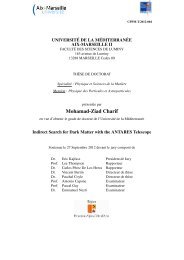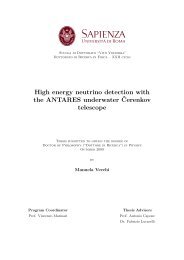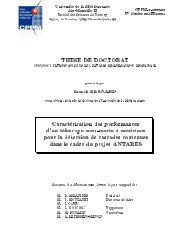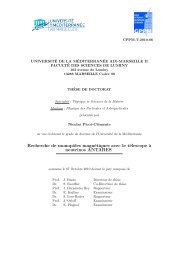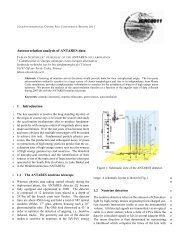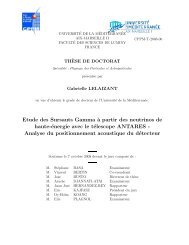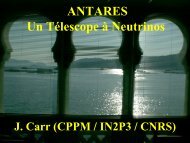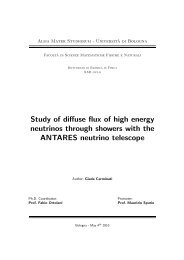Chapter 10: Management and quality assurance - Antares - IN2P3
Chapter 10: Management and quality assurance - Antares - IN2P3
Chapter 10: Management and quality assurance - Antares - IN2P3
Create successful ePaper yourself
Turn your PDF publications into a flip-book with our unique Google optimized e-Paper software.
Resource ManagerP. de Witt-HubertsDocumentationC. TaoBudgetJ. CarrPlanningJ. BeltramelliQC: Test DefinitionY. Le GuenQC: TraceabilityC. TaoQC: FMECAA. CalzasInfrastructureJ-J. DestelleShore StationJ-J. DestelleSerra InstallationsJ-J. DestelleSea CableA. CalzasShore Power SupplyA. CalzasJB IntegrationJ-J. DestelleJBPower DistributionA. CalzasLogisticsM. JacquetIntegrationP. LamareProduction AssemblyP. LamareLogisticsM. JacquetProd. Test SystemF. FeinsteinSector Line PrototypeP. CoyleProto. Test SystemG. HallewellLogisticsM. BillaultInstitution BoardDeputy spokesmanL. MoscosoSpokesmanJ. CarrTechnical CoordinatorP. VerninPublications Committee Steering CommitteMechanicsM. AnghinolfiElectronicsC. OlivettoReadoutM. de JongLine MechanicsM. JacquetLCM/SCM ChassisC. OlivettoDAQ OffshoreH. LeProvostUmbilical CablesP. LamareClock OffshoreC. OlivettoDAQ OnshoreM. de JongBottom String SocketP. PiattelliTrigger CardsF. RéthoréOffshore TriggerP. CoyleJunction BoxM. AnghinolfiPower CardsB. BrooksLevel 1 TriggerP. PayreLink CablesP. LamareARS ChipF. DruilloleSlow ControlA. Le Van SuuARS MotherboardJ. FopmaDatabaseY. BenhammouSea operationsP. ValdyNavigationV. BertinEngineeringM. JacquetLogisticsM. BillaultL/SCM_DWDMJ. HogenbirkClock OnshoreF. RéthoréSPME. HeineLCM TestingL. CaponettoSCM TestingM. CircellaDWDMP. RewiersmaDAQ-ARS TestsH. LafouxDAQ CardF. LouisJB Control SystemCPPMShore Station DirectorJ-J. DestelleOptical ModulesJ-P. SchullerOM ProductionF. Desage-ArdellierInstrumentationV. BertinPositioningP. KellerLED BeaconsL. ThompsonLaser BeaconsJ.J. Hern<strong>and</strong>ezInstrumentation LineA. CaponePhysics StudiesL. MoscosoAstrophysicsT. MontaruliNeutralino SearchL. ThompsonNeutrino OscillationsR. HubbardUltra High EnergyJ. EngelenANTARES OrganigramVersion 13 June 20011km3 ProjectN. de BottonSite ExplorationsJ-P. SchullerAcoustic DetectionA. Le Van SuuFuture ElectronicsR. PotheauPMT R&DH. LafouxSoftwareJ. BrunnerSoft. MaintenanceT. StolarczykReconstructionT. StolarczykMonte CarloJ. BrunnerOffline Phys. FilterM. SpurioWeb External PagesT. StolarczykWeb Internal PagesJ. Brunner
egular intervals to the spokesman, steering committee <strong>and</strong> collaboration.Resource ManagerA group of organisational tasks are linked under the responsibility of the Resource Manager (RM),a post analogous to that of sub-project coordinator. Among these tasks are the documentation,budget <strong>and</strong> planning aspects of the project. The RM will h<strong>and</strong>le the Memor<strong>and</strong>a of Underst<strong>and</strong>ingbetween the Institutes <strong>and</strong> the ANTARES Finance Review Committee. Quality Control falls underthe responsibility of the RM.Steering CommitteeThe sub-project leaders plus the executive management form the project Steering Committee thatmeets, typically, once per month to follow the project progress in all aspects. The SteeringCommittee helps the Spokesman manage the project budget <strong>and</strong> maintain the schedule.Technical DecisionsIn general, technical decisions will be presented to <strong>and</strong> discussed by the full collaboration duringthe regular meetings. Only major aspects will be considered by the Steering Committee <strong>and</strong>Institution Board. Most decisions will be made by the sub-project coordinators <strong>and</strong> members of theirteams. The Technical Coordinator has a control responsibility for all technical decisions of theproject.Publication CommitteeThe publication committee is chaired by the Deputy Spokesman <strong>and</strong> is described in a set ofregulations.Page <strong>10</strong>-4
Operational ReliabilityThis chapter establishes the provisions for the programme regarding product- <strong>and</strong> <strong>quality</strong><strong>assurance</strong> of the ANTARES 0.1 km 2 detector. The product <strong>assurance</strong> programme described hereinwill apply to design, procurement, system integration <strong>and</strong> testing of sub systems.ObjectivesA key issue for the ANTARES detector is the level of reliability required to ensure optimalavailability for physics data taking <strong>and</strong> affordable maintenance cost. The latter condition is imposedbecause of the relatively large cost <strong>and</strong> effort involved in off-shore recovery <strong>and</strong> repair operations.The objective set for operational reliability of the entire instrument is the following:The planned operational lifetime of the detector is ten years. After three years of operation, withneither corrective nor preventive maintenance applied, on average not less than 85% of the OpticalModules will be operational. The systems that could be subject to single-point-failure (the JunctionBox <strong>and</strong> the Electro Optical Cable) should have a probability of failure smaller than <strong>10</strong>% in tenyears.Note that the probability of failure of an OM equals the combined probability of failure at allrelevant functional levels in the chain from OM, LCM, SCM/SPM, JB, MEOC to the shore station.Product- <strong>and</strong> Quality AssuranceQuality-<strong>assurance</strong> tools will be applied in the three phases of implementation of the instrument:design, procurement, testing <strong>and</strong> system integration.Quality-<strong>assurance</strong> tools applied are the following● Failure Modes, Effects <strong>and</strong> Criticality Analysis (FMECA).● Minimisation of Single Point Failures (SPF)● Logbooks, test reports <strong>and</strong> status documentation that will accompany all objects <strong>and</strong>subsystems of the instrument with the objective to ensure traceability. Test reports areformally approved by the signature of the person responsible for the test.The objective of FMECA is to identify the effects of assumed failures <strong>and</strong> in particular to identifycritical failure effects, specifically all single point failures (SPF).A single point failure is a failure of a non-redundant item, component or part caused by a singlefailure mechanism, resulting in an irreversible failure of maximal criticality or having catastrophicor critically hazardous consequences.FMECA will initially start with assumed failure modes, proceed on assembly level <strong>and</strong> finalise oncomponent level, if necessary. The goal of FMECA is also to give the involved parties insight intothe analysis of any failure propagation over the interface. The following failure modes will beconsidered in the FMECA:● Severity of effect of a failure mode● Likelihood of a failure modePage <strong>10</strong>-5
●Error detection modalityThe following criticality categories will be used in the FMECA:SeverityThree types of severity are distinguished:●●●Loss of functionality - from marginal (one OM lost), to one string lost, to total detector lost;scale from 1-8.Loss of material (e.g. a string is released <strong>and</strong> wrecks) - from one OM lost to full detectorlost;scale from 3-9.Personnel hazard -from harmless to casualty;scale from 1-<strong>10</strong>.There should be no compromise on safety issues (cf. section on Safety Assurance)The overall figure on the scale of severity is constructed by taking the maximum of the threeseparate figures.LikelihoodLess frequent than once every <strong>10</strong>0 years to once every hour;scale from 1-<strong>10</strong>.Error detection modalityFrom detectable before immersion to not detectable;scale from 1-8.For several major sub-systems described in this Technical Design Report, a FMECA has beencarried out <strong>and</strong> the results of the analysis was used to improve the robustness of the designwherever achievable.Design levelThe design principles have emphasized the need to find the most reliableconfiguration/architecture feasible under the constraints of the available budget <strong>and</strong> humanresources. For example, the applied concept of sectorisation in a detector string - resulting in apartial star network- enhances its graceful-degradation characteristics.On the other h<strong>and</strong>, the quantity of complex electronics located in the sea is appreciable: Dataacquisition comprising a complex ASIC, the analog ring sampler ARS1, the DAQ processor board,opto-electronics including Dense Wavelength Division Multiplexing <strong>and</strong> Giga bit/s ethernetconnections.The design will be such that Single Point Failures (SPF) will be avoided as far as feasible;otherwise a rationale for their retention will be provided. Single point failures in the sea-borne partsof the ANTARES detector are essentially limited to the Electro Optical Cable <strong>and</strong> the JunctionBox, in particular where the electric-power function of the latter is concerned. Concerning theJunction Box, a design of similar complexity <strong>and</strong> subject to similar reliability requirements iscurrently operational for ocean surveillance purposes. Design concepts applied to the JB have beenin part derived from this example.In the chapter on the Electrical Power System (EPS), an account of the applicable FMECA isgiven. In addition the Mean Time Between Failure (MTBF) is calculated, within specific modelPage <strong>10</strong>-6
constraints.Design ReviewEvaluation of the design will be implemented with a technical design review by experts that arenot associated with the ANTARES project. The TDR will form the basis of the evaluation.Procurement <strong>and</strong> manufacturingComponents <strong>and</strong> materials will be selected for best possible MTBF compatible with availability<strong>and</strong> acceptable price. Component lists <strong>and</strong> the rationale for their selection are included in the TDR.The present engineering design is based on extensive know-how obtained in previous deep-seaexperiments <strong>and</strong> prototype tests. In particular the recent Demonstrator Line experiment has shownthat:● Launching of a set of interconnected storeys equipped with Optical modules is wellmastered, i.e. OM-integrity OK, connectors <strong>and</strong> connecting cables intact.● Connection on deck of the vessel to an EOC is under control.● Short term (several months) corrosion is not an issue.● The acoustic positioning system satisfies specifications.● Adequate time reserved for <strong>quality</strong> <strong>assurance</strong>, system integration <strong>and</strong> strict respect forprocedures is indispensable.For the interfaces of mechanical, metallic parts, material combinations will be selected tominimise contact potentials <strong>and</strong> galvanic corrosion. An example is given in the chapter onMechanics, where the Junction Box configuration is described. In the production process of the JB,a <strong>quality</strong> <strong>assurance</strong> programme will be implemented by the industrial manufacturer. In this case,where a single-point-failure risk is involved, control of the QA-programme implementation will beensured by an independent expert firm.In order to prevent major delays during fabrication, integration <strong>and</strong> testing, a spare part policy of5-<strong>10</strong> % of the baseline amount of components will be applied.The procurement of a spare Junction Box is not considered feasible in the current phase of theproject.System integration <strong>and</strong> testingTesting of sub-systems comprises two major phases:1. Functional tests of electronics boards, which will be subjected to a sequence of environmentalconditions that exceed operational end-use specification in an Accelerated Stress Testing (AST)procedure. The purpose of applying AST is to eliminate most of the faulty items associated with the"infant mortality" phase of the st<strong>and</strong>ard reliability-versus-time curve.The scenario of AST for the LCM electronics has been established as follows:● Temperature cycling from <strong>10</strong>-40 °C with four cycles of 2 hours● Vibration with 3g acceleration at 50 Hz for 30 minutesCompliance with functional specifications after AST will be assessed <strong>and</strong> documented. SimilarAST scenarios apply to other objects - see the relevant chapters in this TDR. Once product <strong>quality</strong>has been assured with AST on item level, the prototype of a set of objects assembled into asub-system (e.g. the LCM electronics) is subjected to a qualification test to anticipate upcomingenvironmental conditions.Page <strong>10</strong>-7
2. In order to ensure product <strong>quality</strong> at the moment of arrival at the site where system assemblytakes place <strong>and</strong> in the subsequent phase of launching the detector string, the life profile of productsfrom the moment of shipment from the forwarding laboratory has been established.The life profile includes the following phases <strong>and</strong> related environmental conditions, as applicableto the Local Control Module equipped with its electronics cards - see also the <strong>Chapter</strong> onElectronics.● Thermal shock at immersion - 50-15 ºC● Vibrations <strong>and</strong> shocks- sinusoidal 5-55 Hz, simulates transport; shocks of 15g during 20 ms● Atmospheric conditions - storage with container open: damp heat 50 ºC at 93% Relativehumidity ; salt fog - container closed on quay for one month with 50 ºC● Free fall from 70 cm on concrete floor - test whether object functionality is OK or not afternon-st<strong>and</strong>ard h<strong>and</strong>ling event.The methodology applied conforms to the IFREMER recommended st<strong>and</strong>ard XPX <strong>10</strong>-812. Ingeneral, all container-like items will be subjected at prototype level to hyperbaric tests performedwith the test facilities of IFREMER-Brest in accordance with the st<strong>and</strong>ards applicable tooceanographic instruments.Post Test ReviewAfter completion of each major test sequence a Post Test Review Board will be organised todetermine that the test results conform to its specifications. The Board may consist of the followingpeople:● Spokesman● Technical Coordinator● Resource manager● Other specialists (on request)The aim of the review is to verify that:● the test was properly executed,● test procedure deviations are properly documented,● required test data are complete <strong>and</strong> adequate,● non-conformances have been recorded.Historical Records (Logbooks)Logbooks will be established for all operations <strong>and</strong> tests to record the history of operations. Theywill include historical record sheets with data of operation/test/transport, applicable procedures,responsible organisation <strong>and</strong> person. The logbooks will accompany the hardware. Further details ofthe documentation system setup for ANTARES are given in the next section.Safety AssuranceA preliminary description of the scope of the safety <strong>assurance</strong> programme to be implemented forthe ANTARES project is given. The basic elements of the safety programme are:● establishment of safety requirements;● identification of hazards;● hazard reduction;● safety <strong>assurance</strong>.The main areas of safety concern for the ANTARES programme fall into two categories are:Page <strong>10</strong>-8
● ground operations, comprising integration <strong>and</strong> test, transportation <strong>and</strong> h<strong>and</strong>ling <strong>and</strong>pre-launch operations;● sea operations.The practical implementation of safety <strong>assurance</strong> <strong>and</strong> the assignment of safety responsibility willbe set up as soon as possible.Page <strong>10</strong>-9
The ANTARES DocumentationExisting ANTARES documentsThere are different types of ANTARES documents,stored on via the ANTARES WEB site inCPPN Lyon, http://antares.in2p3.fr/. Some documents are accessible to everyone (Public), othersare accessible to everyone in the collaboration with a common password (Internal) <strong>and</strong> some are onprivate areas (Privileged) with privileged access.Internal notes: Internal technical <strong>and</strong> physics notes from ANTARES are entered <strong>and</strong>accessed via the Web. Copies of transparencies shown in ANTARES meetings are alsoaccessible.Scientific communication: publications, conference presentations,...Public Communication tools: photo library, videos, posters, plaquettes, maquettes,animation tools, ...Software for simulations, reconstruction, physics analysis, test software, bibliographies, ..Additional Documents needed for 0.1 km 2 detectorThe development of the ANTARES project requires the establishment of additionaldocumentation, such as a general database, <strong>and</strong> logbooks. These will include information relevantto the different stages of the ANTARES experiment, from the construction time, assembly, testing,to the online control of the detector, monitoring, the exploitation of the data, <strong>and</strong> the maintenance ofthe detector.People involved in producing these documents are primarily the subproject coordinators, but mosttechnical members of the collaboration will have to enter data at some point.For the database to be used in tests <strong>and</strong> for future online <strong>and</strong> offline purpose, a technical interfacehas been set up with the users via the WEB, <strong>and</strong> ORACLE8i has been selected for themanagement of this database.It is the responsiblity of each subproject leader to:● define the preliminary content of the database file. For each individual object, the minimalcontents are:- the object name, PBS number, serial number- person entering the data <strong>and</strong> time of entry- data needed for traceability of the object: location in detector or instorage,- status (assembled, labelled, mounted, tested OK, returned forfailure,...), date of change of statusAdditional information will often be necessary concerning items such as: assembly,sector test, line test, deployment, detector maintenance, online control, readout,online monitoring, online reconstruction, offline analysis.● ensure that this draft database entry has been checked by all relevant persons;Page <strong>10</strong>-<strong>10</strong>
●liaise with the database manager to set up the appropriate file format <strong>and</strong> data entry tools;● manage the file contents (ensure the information is accessible <strong>and</strong> up to date). Themanagement of the actual files(backup, structure,etc...) is the responsibility of databasemanager.Logbooks are a necessity at every level of the ANTARES project. Examples can be found underthe Site Evaluation <strong>and</strong> Demonstrator ("Line 5") Web pages. For the 0.1 km 2 detector, a record ofall stages in the assembly <strong>and</strong> testing of each component should be stored, in any readable format(ASCII, HTML, PDF, PS), on the Lyon computer system for easy Web access by ANTARESCollaboration members. A tool analogous to that used for the publication of ANTARES notes willbe provided for that purpose. These logbooks are the principal means of ensuring traceability in theproject.Online logbooks from data acquisition during the running of the experiment are automaticallyrecorded by the online computers. They should be immediately accessible to the ANTAREScollaboration to allow remote monitoring of the experiment <strong>and</strong> provide diagnostic information inthe event of problems.Rules of acceptation, approval <strong>and</strong> evolution of documentsDocuments should be circulated to the appropriate subproject or physics working group <strong>and</strong>approved before their being entered on the system. Entry is performed using an automatic tooloffering several options:- Enter a new document ( a new number is automatically released)- Enter a new version of an existing document (the version number is increased)- Delete an existing document.Documents may be entered in the repository in any WEB readable format (PS, PDF, HTML,Word). In the case of PS or PDF documents, authors are encouraged to provide separate filescontaining figures <strong>and</strong> tables (in source format, e.g., Tex, Word, jpeg, gif, ...) for use inpresentations, papers, etc...It is the responsibility of each author to inform the collaboration of the existence of a newdocument or a new version.Page <strong>10</strong>-11
Role of the databaseThe database is used for:●●detector assembly <strong>and</strong> integration : at each step of the construction, different parametershave to be recorded at different sites. A World Wide Web interface will be used to record allthese data in a central database in CC<strong>IN2P3</strong> in Lyon;centralising the running conditions of the detector <strong>and</strong> the data taking actions. It is alsoused to store <strong>and</strong> retrieve the calibration information for hardware devices.Database as a tool for detector assemblyData entryMeasurements for ANTARES take place in various sites. Due to the large number ofdetector parts to characterise, test <strong>and</strong> store, it is necessary to record all these data<strong>and</strong> the history of each part in a central database to be able to find exactly whathappened <strong>and</strong> where for each component.Assembly stageOnce subsets are in the final site, operators can construct lines <strong>and</strong> use the webinterface to know which component is available, tested, qualified.For example, to construct a sector, the operators will have a list of OM, cables, LCM,MLCM.Accessing web pagesThere are two kinds of users : ``readers'' <strong>and</strong> ``writers''. Every member of thecollaboration has reading privilege of the database. ``Writers'' have an accountwhich allows them to read <strong>and</strong> write data, via the web interface, into tables of thedatabase.Example of a databaseFor the construction of Optical Modules realised in Saclay, 14 tables have beencreated, which can be found on the WEB:● cages : cage\_stock, cage\_history● LED : LED\_stock, LED\_history● PMT Bases : PMT\_Base\_stock, PMT\_Base\_history● spheres : sphere\_stock, sphere\_history● PMT : PMT\_stock, PMT\_charac, PMT\_history● OM : OM\_general, OM\_test, OM\_historyOnly Saclay operators can fill these tables whereas the whole ANTAREScollaboration can read them.Database for Slow Control use: cf <strong>Chapter</strong> 4 in Readout, Trigger <strong>and</strong> DAQSt<strong>and</strong>ard tools used for the databasePage <strong>10</strong>-12
ORACLE8i has been chosen for the database management system. User interfaces forconstruction tools are built using WEBDB (another ORACLE product) <strong>and</strong> the slow controldatabase system is based on JAVA <strong>and</strong> C ++ code.Page <strong>10</strong>-13
Product Breakdown Structure (PBS)A line (or string) is made of 6 sectors <strong>and</strong> each sector is a system formed by 5 subsystems,called storeys (or floors), each with different objects:Components : elements that form an objectObjects : LCM, SCM, OM, laser, LED optical beacon, ...Subsystems : Storey, BSS, JB, cablesSystems : sector, line (or string)Each component is given a PBS name <strong>and</strong> number to ease retrieval of information,ensuring a unique definition, <strong>and</strong> helping identifying missing objects.A schematic view of the distribution of main objects in ANTARES can be viewedhere.PBS 1.- Mechanics●PBS 1. 1 Junction Box: Mechanics partPBS1.1.1 JB FramePBS1.1.2 JB_ContainerPBS1.1.2.1 JB Vessel 2 Ti hemispheres <strong>and</strong> a cylind. spacerPBS1.1.2.2 JB DiaphragmSeparates the transformer to theelectronic volumesPBS1.1.2.3 Feed-throughs Transmit power <strong>and</strong> diagnostic (7)PBS1.1.2.4 PRE-JBHolds penetrator for connection to MainEO cablePBS1.1.2.5 JB O-ringPBS1.1.2.6 Balancing devicePBS1.1.3 JB Transponder support●PBS1.2 Bottom String SocketPBS1.2.1 BSS Structure Recoverable part of the BSSPBS1.2.2BSS Dead WeightUnrecoverable part of theBSSPBS1.2.3 BSS RX_Hydrophone SupportPBS1.2.4 BSS Pressure Sensor SupportPBS1.2.5 BSS Sound velocimeter SupportPage <strong>10</strong>-14
PBS1.2.6SPM/SCM ContainerHosts the Powercomponents <strong>and</strong> StringControl electronicsPBS1.2.6.1 SCM tubePBS1.2.6.2SCM End CapPBS1.2.6.3 Central Junction PartPBS1.2.6.4 SPM tubePBS1.2.6.5 SPM end capPBS1.2.7 SPM/SCM Support●PBS1.3 StoreyPBS1.3.1 OMF Structure of the StoreyPBS1.3.2 LCM Container Houses electronics for the storeyPBS1.3.3 LCM support Support of LCMPBS1.3.4 OM support Support of OMsPBS1.3.5PBS1.3.6PBS1.3.7HydrophonesupportOMF interfacewith EMCLED Opticalbeacon supportSupport of hydrophoneInterface device carrying cablesSupport of Optical Beacon●PBS1.4 CablesPBS1.4.1PBS1.4.2Interconnecting link ILElectromechanical cableEMCLink between the line <strong>and</strong> the JunctionBoxSection of cable in the line betweenstoreys or BSS <strong>and</strong> bottom storeyPBS1.4.2.1 Cable Electro-mechanical cablePBS1.4.2.2MechanicalterminationInterface between cable <strong>and</strong> OMFPBS1.4.2.3 PenetratorElectro-optical interface between cable<strong>and</strong> LCMPBS1.4.3 SPM – SCM link Link between the SPM <strong>and</strong> the SCMPage <strong>10</strong>-15
●PBS1.5 BuoyPBS 2.- Electronics●PBS2.1 LCM Local Control ModulePBS2.1.1PBS2.1.2PBS2.1.3PBS2.1.4LCM_CRATELCM_BACKCOMPASS_MBARS _MBSupport of boards <strong>and</strong>backplaneDistributes signals betweenboards in LCM crateMotherboard for the tiltmetercompasssensorAnalog pipeline with ADCconversion from PMT signalPBS2.1.4.1 ARS ARS Chip on ARS_MBPBS2.1.5PBS2.1.6PBS2.1.7PBS2.1.8PBS2.1.9PBS2.1.<strong>10</strong>PBS2.1.11PBS2.1.12PBS2.1.13PBS2.1.14PBS2.1.15PBS2.1.16LCM_BIDICONLCM_TRIGLCM_CLOCKACOUST_RX_PREAMPACOUST_RX_DSPACOUS_RX_CPUPOWER_BOXLCM_OPTCONUNIV1BIDIANT2BIDITRIG1MLCM_DWDMConcentrates 4 opticaltransceivers from each LCMslave DAQ channelReceives trigger from ARSboards <strong>and</strong> constructs triggerfunctionReceives optical clockdistribution signal <strong>and</strong>distributes inside LCM crateAcoustic positioning systempreampli boardAcoustic positioning systemDSP boardAcoustic positioning systemCPU boardConverts 400V to neededvoltagesOptical <strong>and</strong> electricalconnections between maincable <strong>and</strong> LCM crateDaughter board plugged onother board for Slow ControlMODBUS interfaceDaughter optical transceiverboard for Ethernet <strong>and</strong> ClocksignalsDaughter optical transceiverboard for trigger signalsDWDM transceiver boardwith laser, receiver <strong>and</strong>DWDM filter or circulatorPage <strong>10</strong>-16
PBS2.1.17LCM_DAQ/SCData <strong>and</strong> Slow Control boardwhich sends <strong>and</strong> receivesEthernet ProtocolPBS2.1.18 MLCM_ Switch●PBS2. 2 SCM String Control ModulePBS2.2.1PBS2.2.2PBS2.2.3PBS2.2.4SCM_CRATESCM_BACK1SCM_WDM1SCM_REPSupport of boards <strong>and</strong>backplaneDistributes signals betweenboards in SCM crateOptical transceiver WDMwith clock distributionOptical transceiver toregenerate clock signalPBS2.2.5 SCM_CLOCK Clock Distribution for SCMPBS2.2.6 SCM_DWDMPBS2.2.7 ACOUST_RXTX_EMPBS2.2.8 ACOUST_RXTX_PREAMPPBS2.2.9 ACOUST_RXTX_DSP2PBS2.2.<strong>10</strong> ACOUST_RXTX_DSP1PBS2.2.11 ACOUST_RXTX_CPUPBS2.2.12 ACOUST_RXTX_POWPBS2.2.13 SCM_OPTCONPBS2.2.14 SCM_DWDM_ MUX/DEMUXOptical transceiver for DWDMfunction with laser <strong>and</strong> receiverpartAcoustic positioning systememitter boardAcoustic positioning systempreampli boardAcoustic positioning systemDSP boardAcoustic positioning systemDSP boardAcoustic positioning systemCPU boardAcoustic positioning systempower boardOptical connections betweenmain cable <strong>and</strong> SCM crateOptical mux <strong>and</strong> demux toseparate or mix wavelengthsfrom shore or Master LCM●PBS2.3 SPM String Power ModulePBS2.3.1 SPM_CRATE Support of boards <strong>and</strong> backplanePBS2.3.2SPM_BACK1Distributes signals between boards inSPM cratePBS2.3.3 SPM_CONNECT1 Connections inside SPMPBS2.3.4 SPM_CONNECT2 Connections inside SPMPage <strong>10</strong>-17
PBS2.3.5 SPM_CONT1 Controls power distributionPBS2.3.6 SPM_CONT2 Controls power distributionPBS2.3.7 SPM_CONT3 Controls power distributionPBS2.3.8 SPM_CONT4 Controls power distributionPBS2.3.9 SPM_LV Produces low voltagePBS2.3.<strong>10</strong> SPM_TRANS1 Transformer for HV ACPBS2.3.11 SPM_FILT1 Electrical filter for power conversionPBS2.3.12 SPM_REGUL Voltage regulatorPBS2.3.13 SPM_DC/DC DC/DC conversionPBS2.3.14 SPM_FILT2 Electrical filter on outputPBS2.3.15 SPM_HEAT1 Heat dissipator●PBS 2.4 Junction Box: Clock distribution <strong>and</strong> trigger constructionPBS2.4.1 JB_ELECBOX Contains electronics boardsPBS2.4.2 JB_SPLIT1 Passive splitters for clock distributionPBS2.4.3 JB_TRIG1 RoR signal construction●PBS2.5 ONSHORE Clock Master Clock onshorePBS2.5.1 ON_CRATE1PBS2.5.2 ON-GPSPBS2.5.3 ON_CLOCKPBS2.5.4 ON_WDMElectronics crateGPS receiver producing reference signal for clockdistributionCoding /decoding orders for clock distributionOptical transceiver for clock distributionPBS2.5.5 ON_SYNCPC1 PC boardPBS2.5.6 ON_PCIODigital interface for ON_CLOCK boardPBS 3.- Readout, Trigger <strong>and</strong> DAQ Hardware PBS defined in other chaptersPage <strong>10</strong>-18
PBS 4.- OM Optical ModulePBS4.1 Photo-multiplier Light sensitive detectorPBS4.2 OM-LCM link Interconnecting cable between OM <strong>and</strong> LCMPBS4.3 Glass sphere External envelope of the Optical ModulePBS4.4 Magnetic shield µ-metal cagePBS4.5 Gel Glue <strong>and</strong> optical contactPBS4.6 Base Power supply <strong>and</strong> output signals accessPBS4.7 LED system Internal calibration systemPBS4.8 Tools Tools for integration <strong>and</strong> testsPBS 5.- Instrumentation●PBS5.1 ACOUSTIC Acoustic positioning systemPBS5.1.1 ACOUSTIC _RXPBS5.1.1.1 RX_CARDSPBS5.1.1.2 RX_HYDROPHONEPBS5.1.1.3 RX_HYDRO_BULKHEADPBS5.1.2 ACOUSTIC _RXTXPBS5.1.2.1 RXTX_CARDSPBS5.1.2.2 RXTX_HYDROPHONEPBS5.1.2.3 RXTX_HYDRO_BULKHEADPBS5.1.3 ACOUSTIC _CONTROLAcoustic receivermoduleAcoustic receiverelectronic boardsAcoustic receiverhydrophone & cableAcoustic hydrophonecable bulkheadAcousticemitter-receiver moduleAcoustic emitter-receiverelectronic boardsAcoustic emitter-receivertransducer & cableAcoustic transducercable bulkheadDedicated computer <strong>and</strong>softwareto control the acousticsystemPBS5.1.4 ACOUSTIC _PRESS Pressure sensorPBS5.1.4.1 PRESS_SENSORPressure sensorcontainer & probePBS5.1.4.2 PRESS_CABLE Pressure sensor cablePage <strong>10</strong>-19
PBS5.1.4.3 PRESS_BULKHEADPressure sensor cablebulkheadPBS5.1.5 ACOUSTIC _SVELMeasure the soundvelocitySVEL_SENSORSound velocimetercontainer & probePBS5.1.5.2 SVEL_CABLE Sound velocimeter cablePBS5.1.5.3 SVEL_BULKHEADSound velocimeter cablebulkheadPBS5.1.6 ACOUSTIC _SVEL-CTDMeasure the soundvelocity<strong>and</strong> Conductivity,Temperature, DepthPBS5.1.6.1 SVEL-CTD_SENSORSound velocimeter-CTDcontainer & probePBS5.1.6.2 SVEL-CTD_CABLESound velocimeter-CTDcablePBS5.1.6.3 SVEL-CTD_BULKHEADSound velocimeter-CTDcable bulkheadPBS5.1.7 ACOUSTIC _TRANSPAutonomous acoustictransponderPBS5.1.7.1 TRANSP_CONTAINERTransponder electroniccontainerPBS5.1.7.2 TRANSP_HYDROPHONE Transponder transducerPBS5.1.7.3 TRANSP_CABLETransponder transducercablePBS5.1.7.4 TRANSP_FRAMETransponder mechanicalframePBS5.1.7.5 TRANSP_BASETransponder supportingbasePBS5.1.8 ACOUSTIC _PRESS-ABSMeasure the absoluteatmosphericpressure●●PBS5.2 TILT_COMPASS Sensor board measuring tilt angles <strong>and</strong> headingPBS5.3 LED_OB LED Optical BeaconPBS5.3.1 BEACON_CABLEUmbilical link between LCM <strong>and</strong>Optical BeaconPBS5.3.2 BEACON_CYLINDER High pressure containment vesselPBS5.3.3 BEACON_FACEPCB with 5 pulser-LEDs <strong>and</strong>accompanying logicPBS5.3.4 BEACON_ MOTHERBOARDPower <strong>and</strong> Logic Interfacebetween LCM <strong>and</strong> Optical BeaconPBS5.3.5 BEACON_MOUNTINGMechanical structure ontowhich Optical Beacon faces aremountedPage <strong>10</strong>-20
PBS5.3.6 BEACON_PMT Low voltage PMT●PBS5.4 LASER_OB Laser Optical BeaconPBS5.4.1LB_CONTAINERTitanium container equipped witha glass rod <strong>and</strong> a electrical connectorPBS5.4.2 LB_CABLE Electrical cable with connectorsPBS5.4.3 LB_BULKHEAD Bulkhead of Laser Beacon cablePBS5.4.4 LB_LASER Green laser sourcePBS5.4.5 LB_DIFFUSER Lambertian diffuserPBS5.4.6 LB_FRAME Inner mechanical framePBS5.4.7 LB_ELEC Electronics boards●●PBS5.5 INST_LINE Instrumentation linePBS5.6 HUMIDITY Humidity sensorPBS 6.- Infrastructure:●PBS6.1 Power HutPBS6.1.1 55kVA Power SupplyPBS6.1.1.1 Tri/mono converterPBS6.1.1.2 Variable voltage transformerPBS6.1.2 20 kVA selfPBS6.1.3 Hut (building)PBS6.1.4 Cable <strong>and</strong> optical platinePBS6.1.5 ElectrodesPBS6.1.6 Shore power cupboardPBS6.1.7 Remote control cupboardPBS6.1.8 Slow Control node●●PBS6.2 Shore stationPBS6.3 Link from shore to seaPBS6.3.1 Main ElectroOptical Cable (MEOC)PBS6.3.2 TerminationsPBS6.3.2.1 Shore terminationPBS6.3.2.2 Sea terminationPBS6.3.2.3 Stress relief devicePBS6.3.2.4 Link for tests (50m with plug)Page <strong>10</strong>-21
●PBS6.4: Junction Box (Power part)PBS6.4.1 Penetrators <strong>and</strong> bulkhead receptaclesPBS6.4.2 Power componentsPBS6.4.3 Power Remote diagnosticPBS6.4.4 Very Low Voltage Power SupplyPBS6.4.5 Cabling <strong>and</strong> ConnectionsPBS6.4.6 SensorsPBS6.4.7 Remote Control●PBS6.5 Sea electrodePBS6.5.1 Electrode <strong>and</strong> its cablePBS6.5.2 Electrode support●PBS6.6 Maintenance equipment <strong>and</strong> proceduresPBS 8.- Sea operations●PBS8.1 LFLBL Low Frequency Acoustic Long Baseline Navigation SystemPBS8.1.1PBS8.1.2PBS8.1.3PBS8.1.4PBS8.1.5PBS8.1.6PBS8.1.7PBS8.1.8PBS8.1.9LF_REF _TRANSPBSS_RELEASE _TRANSPCABLE_RELEASE_TRANSPSUBMARINE _TRANSPJB _TRANSPLF_TRANSP_TELECOMMANDLF _RANGEMETERLF_RANGEM _TRANSDLF_TRANSD_EM _CABLELFLBL acousticreference transponderReleasable acoustictransponder for BSSReleasable acoustic transponderfor winch cable used fordeploymentsAcoustic transponderfor submarine vehicleAcoustic transponder forJunction BoxAutonomous telecomm<strong>and</strong>for LF transpondersLBL multi-channel rangemeterfor LF transpondersRemote tr<strong>and</strong>ucer for the LFrangemeterElectro-mechanical cable forthe remote tr<strong>and</strong>ucer of therangemeterPage <strong>10</strong>-22
PBS8.1.<strong>10</strong> LF_TRANSD_LF _CABLEElectrical cable for theremote tr<strong>and</strong>ucer of therangemeterPBS8.1.11 LF_LBL _COMPUTERControl computer of the LFLBLsystemPBS8.1.12 LF_LBL _SOFTW Software for the LFLBL systemPBS8.1.13 DGPS _RECEIVER DGPS receiver <strong>and</strong> its antennaPBS8.1.14 GYROCOMPASS Gyrocompass●PBS8.2 Ship equipmentPBS8.2.1PBS8.2.2PBS8.2.3PBS8.2.4Workshop containerNavigation ContainerORE fishesBooms●PBS8.3 Tools for sea operationsPBS8.3.1PBS8.3.2PBS8.3.3PBS8.3.4Hooks (Launching <strong>and</strong> Recovery)Deck SupportOMF SupportsInterconnecting Cable ReelPage <strong>10</strong>-23
ANTARES Milestone PlanningThe major- milestone planning of the complete project is presented hereafter.The current, detailed sub-project planning information can be accessed on the ANTARES internalWEB page: http://antares.in2p3.fr/internal/planning/pdf.Jun 2000 Order Acoustic Positioning SystemSep 2000 Order Sea Electro-Optical CableJan 2001 Order Optical Module Components (<strong>10</strong> lines)Jan 2001 Order mechanics parts for sector prototypeJan 2001 Order optical transmitters <strong>and</strong> receivers proto+2 linesMar 2001 Site Survey with CyanaApr 2001 Order Link Cables <strong>and</strong> SocketsApr 2001 Order Navigation SystemApr 2001 Deploy Sea Electro-Optical CableJul 2001 TDR version 1 finishedJul 2001 Mechanical Prototype (5 storeys) Deployment TestJul 2001 Junction Box Deployment Test in shallow waterSep 2001 Integrate electronics complete 1 MLCM, 1 SCM, 1 SPMSep 2001 Pre-assemble mechanics complete prototype sector lineNov 2001 Lab electronics tests finished 1 MLCM, 1 SCM, 1 SPMDec 2001 Deploy Junction BoxJan 2002 Integrate complete PSL: 1 MLCM, 4 SLCM, 1 SCM, 1 SPMMar 2002 Electrical tests finished PSL: 1 MLCM, 4 SLCM, 1 SCM, 1 SPMApr 2002 Calibration finished PSL: 1 MLCM, 4 SLCM, 1 SCM, 1 SPMApr 2002 Integrate Instrumentation LineMay 2002 Prototype Sector Line DeploymentMay 2002 Instrumentation Line DeploymentJun 2002 Connect Prototype Sector <strong>and</strong> Instrumentation linesJun 2002 Order Line Umbilical Cables (<strong>10</strong> lines)Jun 2002 Order Mechanical Parts (2 lines)Jun 2002 Order Electrical Parts (2 lines)Aug 2002 Sea Tests Complete Prototype Sector LineOct 2002 Order Electrical Components (+8 lines)Jan 2003 Deploy 1st lineFeb 2003 Order All Remaining Mechanical Components (+8 lines)Mar 2003 Deploy 2nd lineJun 2003 Connect 1st <strong>and</strong> 2nd linesJul 2003until Deploy 3rd – 6th LinesJan 2004Feb 2004 Connect 3rd – 6th LinesJan-Oct 2004 Deploy 7th-<strong>10</strong>th LinesOct 2004 Connect 7th-<strong>10</strong>th LinesPage <strong>10</strong>-24
Annexes●●●List of acronyms used in the TDRList of unitsMembers of the ANTARES Collaboration as of June 30, 2001
List of acronymsAC Alternative Current (also ac)ADC Analog to Digital ConverterADCP Acoustic Doppler Current ProfilerARS Analog Ring SamplerASIC Application Specific Integrated CircuitAST Accelerated Stress TestingBIDI Bi-DirectionalBSS Bottom String SocketCDR Conceptual Design ReportCRM Counting Rate MonitorCTD Conductivity Temperature DepthDAQ Data AcquisitionDC Direct Current (also dc)DGPS Differential Global Positioning SystemDP Dynamic PositioningDSP Digital Signal ProcessorDWDM Dense Wavelength Division MultiplexingDWFI Dense Wavelength FilterEM ElectromagneticEMC Electro-Mechanical CableEO Electro-OpticalEOC Electro-Optical CableEPLD Electrically Programmable Logic DeviceFEA Finite Element AnalysisFMECA Failure mode <strong>and</strong> effects critical analysisFIFO First-In First-Out
FPGA Field Programmable Gate ArrayFWHM Full Width Half MaximumGPS Global Positioning SystemGUI Graphic User InterfaceHBW High B<strong>and</strong>widthHFLBL High Frequency Long BaseLineHV High VoltageIP Internet ProtocolIL Interconnecting Link Cable from Junction Box to StringJB Junction BoxLAN Local Array NetworkLBL Long BaseLineLBLPS Long BaseLine Positioning SystemLCM Local Control ModuleLED Light Emitting DeviceLFLBL Low Frequency Long BaseLineLSB Least Significant BitLVDS Low Voltage Differential SignalMEOC Main Electro-Optical CableMIL Mini Instrumentation LineMLCM Master Local Control ModuleMTBF Mean time between failureMTBSF Mean time between system failureOB Optical BeaconOC Open CollectorO/E/O Optic/Electric/OpticOM Optical ModuleOMF Optical Module FrameOF Operating lifeOS Operating system
PBS Product Breakdown StructurePE Polyethylenepe photoelectronPIC Microcontroller from MICROCHIP companyPIFC Polarisation-Insensitive Fibre optic CirculatorPLL Phase Lock LoopPMT PhotoMultiplier TubePSD Pulse Shape DiscriminatorPSL Prototype Sector LinePU PolyurethaneRMS Root Mean Square (also rms)RoR Read out RequestROV Remote Operated VehicleRTS Reset Time StampRTOS Real Time Operating SystemSC Slow ControlSCC Serial Communication ControllerSCM String Control ModuleSDRAM Synchronous Dynamic R<strong>and</strong>om Access MemorySPE Single Photo ElectronSPI Serial Peripheral InterfaceSPM String Power ModuleTDR Technical Design ReportTCP/IP Transmission Control Protocol/Internet ProtocolTT Time TransitTTS Time Transit SpreadTVC Time to Voltage ConverterUV Ultra-VioletWDM Wavelength Division MultiplexingWF Waveform
List of units used in the TDRThroughout the TDR, we have used st<strong>and</strong>ard SI units. Please refer to the WEB for the precisedefinitions. One example is http://www.ex.ac.uk/cimt/dictunit/dictunit.htm#SI.Some commonly used non st<strong>and</strong>ard units have been accepted. Here are the definitions:●●●●●bar: unit of static pressure inside a fluid (absolute or differential) =<strong>10</strong> 5 Pabarg: "bar-gauge", gauge pressure scale derived from "bar" unit: P[barg]=Pabsolute[bar] -1. (Subtract atmospheric pressure)inch: (or ") the use is restricted to the 8" or <strong>10</strong>" photomultipliers.PSU: Practical Salinity Unit" = S/<strong>10</strong>00, where S is the "Practical Salinity" of sea water. Forthe (revised 1978) definition of S, see: http://www.start.or.th/got/data/techsupp/pss78.htm(Sea water) Buoyancy: vertical force acting on a solid, which results from the balancebetween gravity <strong>and</strong> the buoyant force in sea water; the specific mass =1 033. kg/m 3 byconvention. The buoyancy is positive if upwards, negative if downwards: B = g (ρ water .V -M) for a rigid body of mass M <strong>and</strong> volume V, where g is the acceleration due to gravity <strong>and</strong>ρ water is the water density.Note 1: 1.033 <strong>10</strong> 3 kg/m 3 is the "typical" sea water density seen during an ANTARESdeployment/recovery at a depth of <strong>10</strong>00 m, with a temperature of 13 ° C <strong>and</strong> a salinity of 38 PSU.Note 2: for the (effective) acceleration of gravity in the Provence coast area, take g=9.805 m/s 2(sea-level value at Marseille).
Members of the ANTARES Collaborationas of June 30, 2001CPPM (CNRS/<strong>IN2P3</strong>, Marseille)E. Aslanides, J-J. Aubert, S. Basa, F. Bernard, V. Bertin, M. Billault, J. Brunner, A. Calzas, J. Carr,P. Coyle, J-J. Destelle, F. Feinstein, M. Jaquet, G. Hallewell, P. Lagier, A. Le Van Suu,F. Montanet, E. Nezri, C. Olivetto, A. Oppelt-Pohl, P. Payre, F. Réthoré, R. Potheau, J-S Ricol,C. Tao.DAPNIA (CEA/DSM, Saclay)S. Anvar, F.E. Ardellier-Desages, R. Azoulay, J. Beltramelli, N. de Botton, G. Dispau, F. Druillole,P. Goret, L. Gosset, J-F. Gournay, R. Hubbard, M. Karolak, H. Lafoux, P. Lamare, J-C. Languillat,H. Le Provost, S. Loucatos, F. Louis, P. Magnier, B. Mazeau, L. Moscoso,N. Palanque-Delabrouille, J. Poinsignon, Y. Queinec, Y. Sacquin, J-P. Schuller, I. Sokalski,T. Stolarczyk, P. Vernin.GRPHE (Université de Haute Alsace, Mulhouse)Y. Benhammou, R. Blaes, C. Ferdi, D. Stubert, O. Suvorova.IReS (CNRS/<strong>IN2P3</strong>, Strasbourg, France)F. Devillez, J-M. Gallone, C. Racca.Centre de Physique Théorique (CPT) (CNRS Marseille)R. Triay, P. Taxil, J-M. Virey.IFREMER (Toulon/La Seyne sur Mer <strong>and</strong> Brest)C. Compère, J. Croquette, J.F. Drougou, D. Festy, G. Herrouin, Y. Le Guen, L. Lemoine,A. Massol, F. Mazéas, J.L. Michel, J.P. Morel, J.F. Rolin, P. Valdy.Laboratoire d’Astronomie Marseille (LAM) (CNRS/INSU Marseille)A. Mazure, P. Amram, J. Boulesteix, M. Marcelin.Centre d’Océanologie de Marseille (COM) (CNRS/INSU Marseille)L. Laubier, C. Millot.IFIC, CSCI – UVEG, ( Valencia, Spain)E. Carmona, J. J. Hern<strong>and</strong>ez, V. Roca-Blay, G. Vaudaine, J.de D. Zornoza, J. Zuniga.ITEP (Moscow, Russia)M. Danilov, V. Lyashuk, A. Rostovtsev, A. Usik, I. Varlamov, E. Vladimirsky, M. Vorobiev, V.Zakharov.
INFN - Sezione di Bari (Bari)R. Bellotti, F. Cafagna, F. Ciacio, M. Circella, C. De Marzo, T. Montaruli.INFN - Sezione di Bologna (Bologna)S. Cecchini, G. Giacomelli, A. Margiotta, V. Popa, M. Spurio.INFN - Sezione di Catania (Catania)L. Caponetto, L. Lo Nigro, D. Lo Presti, C. Petta, N. R<strong>and</strong>azzo, G.V. Russo.INFN - Sezione di Genova (Genova)M. Anghinolfi, M. Battaglieri, R. DeVita, P. Prati, M. Ripani, M. Taiuti, S. Zavatarelli.INFN - Laboratori Nazionali del Sud (Catania)E. Migneco, P. Piattelli, G. Raia, G. Riccobene.INFN - Sezione di Roma (Roma)A. Capone, R. Masullo, M. Petruccetti, E. Salusti, V. Valente.NIKHEF (Amsterdam, Netherl<strong>and</strong>s)M.Bouwhuis, C. Carloganu, R. van Dantzig, R. Donders, J. Engelen, A. Heijboer, E. Heine, J.Hogenbirk, M. de Jong, E. Kok, P. Kooijman, G.J. Nooren, H. Peek, P. Rewiersma, G. Venekamp,R. van Wijk, G. de Vries, P. de Witt Huberts, E . de Wolf .University of Oxford, Sub Department of Particle Physics, OxfordD. Bailey, C.B. Brooks, S. Cooper, J. Fopma, W. Schuster, S. Tilav.University of Sheffield, Department of Physics <strong>and</strong> AstronomyR. Brook, S. Cartwright, V. Kudryavtsev, J. McMillan, J. Roberts, N. Spooner, L. Thompson.



